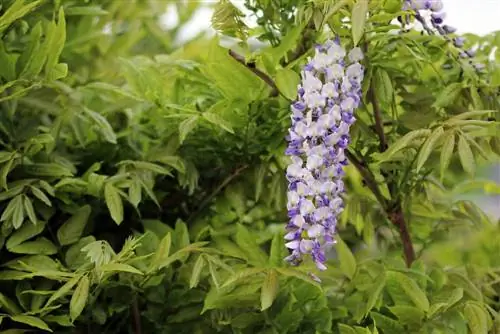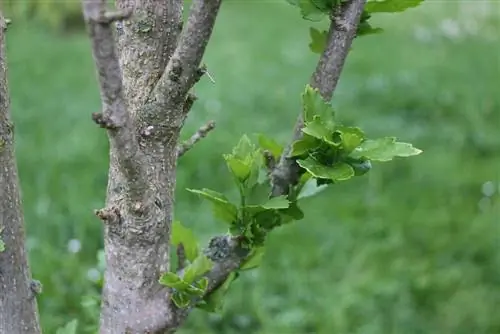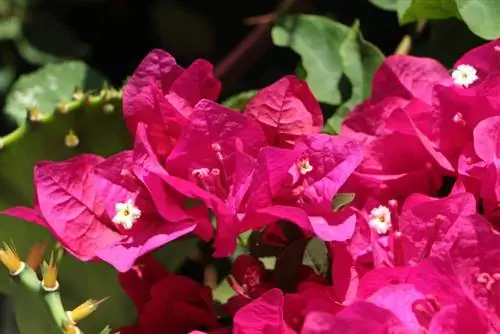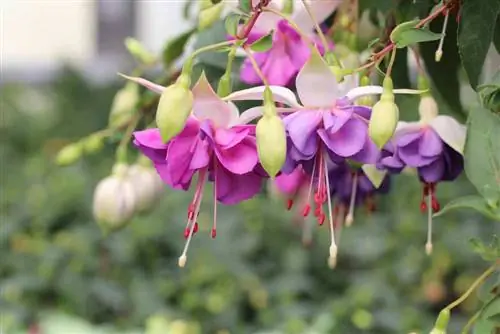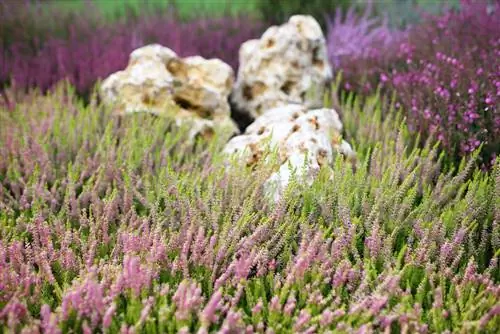- Author admin [email protected].
- Public 2023-12-17 03:39.
- Last modified 2025-01-24 12:45.
Wisteria is a genus with six to ten species. Some of them are valued as ornamental trees with lush flowers. There are now numerous varieties that differ not only in the shape and color of the flowers but also in the flowering time.
Chinese wisteria (Wisteria sinensis)
The butterfly plant develops aesthetic flowers with a pleasant scent that are about two centimeters larger than the flowers of its sister species from Japan. The grapes can grow up to 20 centimeters long and grow to a height of 25 meters. The Chinese wisteria blooms before the leaves emerge, making the exotic tree an attractive eye-catcher in spring. Its flowers shine in sensual shades of blue with violet nuances. Depending on the variety, the blue color varies. All flower buds unfold at the same time.
- first flowering at the age of ten
- Main flowering period from mid-April
- second flowering between June and August, weaker
‘Prolific’
This variety is characterized by deep blue butterfly flowers, which set colorful accents early in the year. The grapes are not only attractive to the human eye. They prove to be magnets for birds and insects. With the early flowering period, which begins in April, this variety of Chinese wisteria proves to be a valuable source of food for the local fauna. Late frosts can destroy the flower buds, making the variety more suitable for cultivation in mild regions.
Tip:
The intense blue flowers of the 'Prolific' variety look particularly good next to the laburnum.
‘Alba’
The white wisteria is rich in contrast, and not just because of its German name. When the white flowers appear in May, the plant becomes a real eye-catcher. They create an aesthetic contrast against dark garden hedges. The butterflies make the garden shine with their clusters of up to 40 centimeters long until June. In individual positions, the flowers of the trees, which are up to 15 meters high, are even more effective.
Japanese wisteria (Wisteria floribunda)
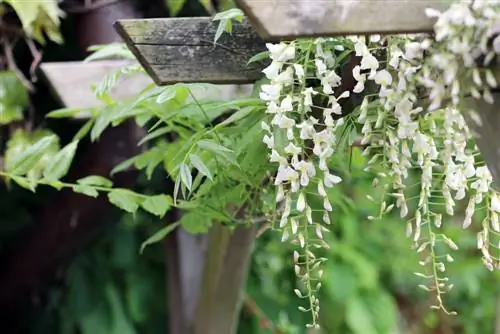
This wisteria impresses with the longest inflorescences of all wisteria species. The grapes are up to 60 centimeters long and are densely covered with large individual flowers. They emerge late, when the leaves have already sprouted. The butterfly-shaped petals are dipped in different colors. The palette ranges from light blue to violet and pink to white. The flag can be white or yellow dotted. The Japanese wisteria impresses with a pleasant floral scent that is reminiscent of grapes.
- blooms between mid-May and June
- Re-bloom possible in late summer
‘Macrobotrys’
This magnificent wisteria is one of the rare varieties of Japanese wisteria, which develops the longest flower clusters. In the right location they can grow up to one meter long. In temperate latitudes, the tree grows up to six meters high and produces inflorescences in spring that are between 30 and 60 centimeters long. The flowering period extends from May to June.
‘Longissima Alba’
The white wisteria decorates gardens and planters in spring with snow-white flowers that grow in 40 to 60 centimeter long clusters. The flowers appear from mid-May and enchant the garden until June. If the wisteria is in a suitable location, it can bloom again in late summer. In this way, the butterflies make September shine.
Tip:
The white flowers of this variety harmonize with the slightly smaller flowers of the Chinese wisteria. Combine two different varieties with different flowering times to enjoy the sea of colors for longer.
American wisteria (Wisteria frutescens)
Among the wisterias, the American wisteria is the species with the smallest flowers. They are only two centimeters tall and grow together in dense clumps. The spherical to grape-shaped inflorescences reach a length of between five and 15 centimeters. Because of its small flowers, the American wisteria enjoys particular attention among bonsai artists.
- Species with the latest main flowering
- Flowers develop in early to mid-June
- individual varieties bloom in May
- Flowering period lasts until August
‘Longwood Purple’
This fast-growing climbing plant bears blue-purple flower clusters that are up to 30 centimeters long and have a strong scent. The breed comes from the American wisteria and blooms on perennial wood. The first flowers usually appear in June. In particularly mild locations, 'Longwood Purple' blooms in May, with or before the leaves emerge. You can enjoy the flowers for a particularly long time, as the variety develops its last flowers in August.
‘Amethyst Falls’ (R)
This American wisteria is one of the rare varieties that blooms at a young age. In May the buds open on the 25 centimeter long panicles. The purple flowers exude an intense aroma that enchants the sense of smell. Insects are also attracted to the colors and scents, so the wisteria also serves as a valuable source of nectar for bumblebees and wild bees. During the flowering period, which lasts until July, the intensely colored flowers gradually take on a white color.
Tip:
The variety is particularly suitable for creating a fairytale oasis because of its compact inflorescences. They green obelisks and trellises near cozy seating areas.
Not blooming
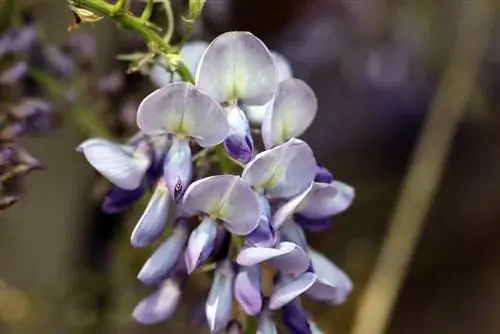
Amateur gardeners always ask themselves why their wisteria doesn't bloom or only blooms unreliably. In addition to suboptimal growth, incorrect care measures can also be a possible cause.
Site conditions
Wisterias require a well-sunlit location on nutrient-rich soil with moist conditions and high permeability. The brighter and warmer the location, the greater the chance of a second annual bloom. South-facing facades are optimal places to grow.
Care and pruning
If you have freshly planted the tree, you must regularly cut shoots during the growth phase. The strong-growing climbing plants tolerate radical pruning. During annual pruning, make sure that no fresh or annual shoots are cut off. Concentrate on the leading shoots, which are thinned out into the perennial wood. These measures promote the formation of flowers, so that you can enjoy a rich floral bloom after just two to three years.
Tip:
When buying, pay attention to refined varieties. These bloom more quickly than freshly grown young plants, which only bloom after a few years.

